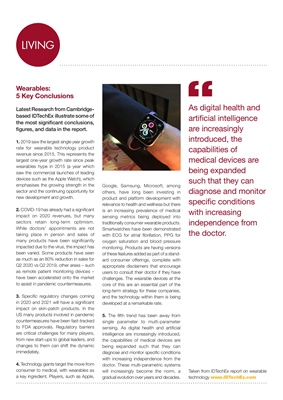
LIVINGLIVING
As digital health and
artificial intelligence
are increasingly
introduced, the
capabilities of
medical devices are
being expanded
such that they can
diagnose and monitor
specific conditions
with increasing
independence from
the doctor.
"
Wearables:
5 Key Conclusions
Latest Research from Cambridgebased IDTechEx
illustrate some of
the most significant conclusions,
figures, and data in the report.
1. 2019 saw the largest single year growth
rate for wearable technology product
revenue since 2015. This represents the
largest one-year growth rate since peak
wearables hype in 2015 (a year which
saw the commercial launches of leading
devices such as the Apple Watch), which
emphasises the growing strength in the
sector and the continuing opportunity for
new development and growth.
2. COVID-19 has already had a significant
impact on 2020 revenues, but many
sectors retain long-term optimism.
While doctors' appointments are not
taking place in person and sales of
many products have been significantly
impacted due to the virus, the impact has
been varied. Some products have seen
as much as an 80% reduction in sales for
Q2 2020 vs Q2 2019, other areas - such
as remote patient monitoring devices -
have been accelerated onto the market
to assist in pandemic countermeasures.
3. Specific regulatory changes coming
in 2020 and 2021 will have a significant
impact on skin-patch products. In the
US many products involved in pandemic
countermeasures have been fast-tracked
to FDA approvals. Regulatory barriers
are critical challenges for many players,
from new start-ups to global leaders, and
changes to them can shift the dynamic
immediately.
4. Technology giants target the move from
consumer to medical, with wearables as
a key ingredient. Players, such as Apple,
Google, Samsung, Microsoft, among
others, have long been investing in
product and platform development with
relevance to health and wellness but there
is an increasing prevalence of medical
sensing metrics being deployed into
traditionally consumer wearable products.
Smartwatches have been demonstrated
with ECG for atrial fibrillation, PPG for
oxygen saturation and blood pressure
monitoring. Products are having versions
of these features added as part of a standard
consumer offerings, complete with
appropriate disclaimers that encourage
users to consult their doctor if they have
challenges. The wearable devices at the
core of this are an essential part of the
long-term strategy for these companies,
and the technology within them is being
developed at a remarkable rate.
5. The fifth trend has been away from
single parameter to multi-parameter
sensing. As digital health and artificial
intelligence are increasingly introduced,
the capabilities of medical devices are
being expanded such that they can
diagnose and monitor specific conditions
with increasing independence from the
doctor. These multi-parametric systems
will increasingly become the norm, a
gradual evolution over years and decades.
Taken from IDTechEx report on wearable
technology www.idtechex.com